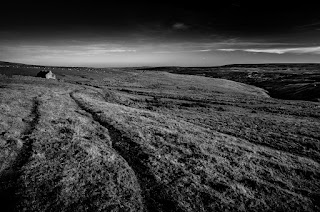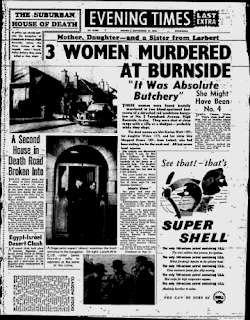Often described as ‘the forgotten victim of Peter Manuel’, the 1957 murder of Newcastle taxi driver Sydney John Dunn is a crime that sits uneasily in the series of Manuel’s crimes - it was the only crime to take place outside of Scotland, the victim male rather than female or a family, with no apparent sexual motive or element of stealth burglary – and even though he was convicted for the crime in 1958, for nearly 60 years there have been rumbling doubts as to whether Manuel actually innocent.
 |
| Newcastle Central Station 1950s |
In the early hours of Sunday the 8th of December 1957 two taxi drivers were waiting under the portico of Newcastle Central Station. The two taxi drivers were Thomas Green and Sydney John Dunn (36), the pair were friends and neighbours – both living on St Thomas Crescent, Newcastle. Thomas Green noticed two men emerge from the station at the same time, one of the men asked to be taken to the Newburn area, six miles away, and the other to a village called Edmondbyers in the moors of County Durham, 22 miles away. Green chose the shorter fare and directed the second man to Dunn’s cab. Green would later describe Dunn’s passenger as approximately 24 years of age, 5 ft 8 inches tall, swarthy, with greased black hair parted to the left, medium build, wearing a single breasted dark suit, no hat, a light shirt, dark tie, and dark grey loose overcoat. Green would later tell police that he had followed Dunn’s cab until they parted company at Scotswood Bridge, what happened after that is still as much a mystery as it was in 1957.
 |
| A Pre War Austin 18, the same model driven by Dunn |
Dunn’s cab would be found some hours later and several miles away, abandoned in a gulley off the main road to Stanhope. A police cyclist came across the abandoned vehicle which was left at a right angle to the road, both the interior and exterior lights were smashed, and both the front and rear driver’s side doors were lying open. There was blood on the steering wheel and a scarf and a peaked cap lay on the grass besides the car. The policeman initially believed that the scene was nothing more ominous than a traffic accident – and cycled the two miles to Edmondbyers to check whether there were any reports of an accident or anyone admitted to hospital with head injuries – but drew a blank on both.
 |
| The desolate Edmondbyers moorland |
A search team was quickly assembled and soon a tracker dog found the body of Sydney John Dunn lying in the heather about 150 yards north of the car. He had clearly been dragged to the spot by the tails of his coat, which had been pulled up and left over his head. His wallet lay nearby, but there were no signs of robbery. A pencil, a lighter, and some coins were also found near the body. A post-mortem would later reveal that the cause of death was a bullet wound to the head. The bullet was thought to be either a .32 or .38, of British make, which had likely been fired at a distance of at least 12 inches from a ‘very worn’ revolver. The blood splatters in the car suggested that the shot had been fired from the front passenger seat. After inflicting the fatal shot to the head, the killer had also exacted a 5 inch gash into Dunn’s throat.
Door-to-door enquiries in Edmondbyers and Stanhope lead nowhere, nor did a search of the surrounding moorland. In particular no one came forward to tell of either seeing, or giving a lift to, an inappropriately dressed man walking along the side of the moors in the midst of a gale - for there was a very real risk of exposure for anyone attempting to walk from where the car was found to a place of shelter. Police were at a loss to explain how the killer had left the scene and even suggested he may have fallen into a peat bog and died. They were equally puzzled as to why the killer had not driven away in the car after dumping the body – could it be that the killer was unable to drive, or somehow unable to restart the car after the murder?
So how was it that the murder of a taxi driver in Newcastle came to be attributed to Peter Manuel, a killer who usually limited his crimes to Glasgow and its outskirts?
 |
| Peter Manuel, 1958 |
Well, Manuel had been in the area at the time of the murder, attending a job interview in Newcastle for British Electrical Repairs Limited on the morning of Friday the 6th of December, the day before the murder. And when a serial killer with a preference for using guns happens to be in the same vicinity as a seemingly motiveless shooting, it takes no great leap to draw a connection between the two. Furthermore, the scattering of Dunn’s belongings recalls similar ‘scatterings’ in Manuel’s earlier crimes.
There were several other important pieces of evidence that were used to convict Manuel of the murder. Grass found in the turn-ups of a pair of Manuel’s trousers was found to be ‘similar to’ that found on the Edmondbyer moors. A button with thread attached recovered from the floor of the cab was ‘similar to’ those of a coat belonging to Manuel. Two red fibres and a yellow thread entwined in that button were thought to have possibly came from clothing belonging to Manuel. And we do know that Manuel committed the Watt murders with a .38 revolver, but it could not have been the same weapon as Manuel disposed of that particular gun immediately after the crime. But most convincingly, the taxi driver Green, who had spoken to Dunn’s passenger, was able to identify Manuel as that man.
Case closed? Well, not quite. If Manuel was indeed the killer, the crime stands out so singularly as being the only one of his murders committed out of his ‘comfort zone’ of Glasgow and its outskirts. Unlike his other crimes, there was no apparent sexual motive, or burglary element. Dunn’s passenger was described by Green as 24 years old, 5 ft 8, with greased black hair, and while Manuel certainly had greased black hair he was also 31 at the time, and 5 ft 4. While the identification by Green seems convincing, police did admit to showing Manuel’s photographs to witnesses in Newcastle, and this may have, perhaps unconsciously, influenced Green’s identification.
For what it’s worth, Manuel himself was adamant that he had been misidentified, after he was questioned about the murder at Barlinnie prison, he reportedly turned to a fellow prisoner and asked ‘What the f*ck was that all about?’ Manuel’s mother, while accepting his guilt on the other murder charges, would later single out the Dunn murder as the one in which she was convinced he was innocent. Manuel himself would never confess to the crime during his life, while confessing to all of the others he was convicted of. While awaiting execution in June 1958, Manuel would write to his friend complaining that he was in the frame ‘for every unsolved murder since Cain killed Abel’ and of the Dunn murder specifically he ambiguously remarked: ‘I wonder where I was that night?’
And so lingering doubts as to Manuel’s guilt in the death of Sydney John Dunn remained for nearly 50 years, until Manuel himself appeared to silence them from beyond the grave. In 2009 a poem composed by Manuel while awaiting his execution was unearthed in the personal papers of Duncan MacKenzie, the former Governor of Barlinnie Prison. In it Manuel described himself as ‘the foulest beast on earth’ and ‘Scotland’s Frankenstein’ – but he also confesses, for the first and only time, to the murder of Sydney John Dunn, writing: ‘I murdered Isabella Cook/And young Anne Knielands too/ Shot the Watts and shot the Smarts/ And Sidney Dunn I slew.’


















